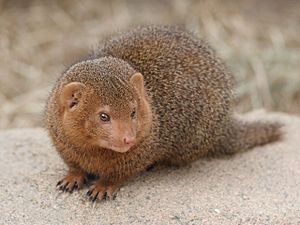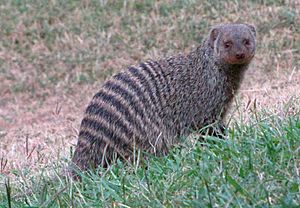Mongoose facts for kids
Quick facts for kids Mongoose |
|
|---|---|
 |
|
| Dwarf Mongoose | |
| Scientific classification | |
| Kingdom: | |
| Phylum: | |
| Class: | |
| Infraclass: | |
| Superorder: | |
| Order: | |
| Suborder: | |
| Infraorder: |
Viverroidea
|
| Family: |
Herpestidae
Bonaparte, 1845
|
| Subfamiles | |
|
Herpestinae |
|
A mongoose is a small, cat-like animal. It belongs to a family called Herpestidae. Mongooses are found in many parts of the world. You can find them in Asia, Africa, the Caribbean, and southern Europe.
Contents
What is a Mongoose?
Mongooses live in southern Asia, Africa, and southern Europe. They also live in places like Fiji, Puerto Rico, and some Caribbean and Hawaiian islands. In these islands, they were brought there by people.
There are 34 different kinds, or species, of mongooses. They can be from 24 to 58 centimeters (about 9 to 23 inches) long. This measurement does not include their tail. The smallest mongoose is the common dwarf mongoose, weighing about 320 grams (11 ounces). The largest is the white-tailed mongoose, which can weigh up to 5 kilograms (11 pounds). This is about the size of a small cat.
Some mongooses live alone and find food by themselves. Other types of mongooses live in groups. They share food with each other and help raise their young.
Mongoose Body Features
Mongooses look a lot like weasels and ferrets. They have long faces and bodies. Their ears are small and round, and their legs are short. They also have long tails that get thinner towards the end. Most mongooses have coats that are a mix of colors, like brown and gray. A few have very clear patterns on their fur.
Their claws do not pull back into their paws. Mongooses use these claws mostly for digging. Their eyes have narrow, oval-shaped pupils, similar to a goat's eyes. Most species have a large scent gland near their bottom. They use this gland to mark their territory. It also helps them signal when they are ready to have babies.
Mongooses have a special protection against snake venom. Their bodies have special parts that snake venom cannot attach to. This makes them resistant to the venom. Mongooses are one of four types of mammals known to have this protection. Pigs, honey badgers, and hedgehogs also have ways to fight off snake venom.
Mongoose Life
Unlike some other animals that live in trees and are active at night, mongooses usually live on the ground. Many of them are active during the day.
The Egyptian mongoose is sometimes thought to be a solitary animal. However, people have seen them working together in groups.
What Mongooses Eat
Mongooses mainly eat insects, crabs, earthworms, lizards, birds, and rodents. They also eat eggs and dead animals.
The Indian gray mongoose is famous for its ability to fight and kill venomous snakes, especially cobras. They are very good at this because they are quick and have thick fur. Their special body parts also make them resistant to snake venom. Even though they can fight cobras, they usually try to avoid them. They also do not particularly like to eat cobra meat.
Some mongooses can learn simple tricks. They can even be partly tamed and kept as pets to control pests like rats. However, they can sometimes cause more problems than they solve. For example, when they were brought to the West Indies to kill rats, they ended up harming many small ground animals. Because of this, it is against the law to bring most types of mongooses into the United States, Australia, and other countries. Mongooses were brought to Hawaii in 1883. They have caused a lot of harm to the animals that naturally live there.
Mongoose Reproduction
When mongooses mate, they make a high-pitched sound. This sound is often called giggling. Giggling can also be heard when they are trying to attract a mate.
How Long Mongooses Live
Scientists do not yet know how long mongooses live in the wild. But, we do know that in zoos or other places where they are cared for, they live for about twenty years.
Mongooses and People
Long ago, in a place called Mesopotamia, mongooses were considered special. They were linked to a god named Ningilin. This god was also connected to Ningirima, a god of magic who protected people from snakes. There was a saying in ancient Babylonia: if a mouse ran from a mongoose into a snake's hole, it would say, "I bring you greetings from the snake-charmer!"
A Greek historian named Diodorus Siculus wrote that Egyptians respected mongooses. They admired their ability to handle venomous snakes. Egyptians also liked that mongooses sometimes ate crocodile eggs.
In some Buddhist beliefs, the god of wealth, Vaiśravaṇa, is often shown holding a mongoose. This mongoose is spitting jewels from its mouth.
The Hindu god of wealth, Kubera, is also often seen holding a mongoose in his left hand. Because of this, seeing a mongoose is thought to bring good luck to some people.
Most mongoose species are not allowed to be brought into New Zealand. Only one type, the Suricata suricatta (which is a meerkat), is allowed.
In Pakistan, mongooses are often part of roadside shows. Snake charmers use mongooses for pretend fights with snakes.
In Popular Culture
One very famous mongoose in stories is Rikki-Tikki-Tavi. He is the main character in a short story from The Jungle Book (1894) by Rudyard Kipling. In this story, which takes place in India, Rikki-Tikki-Tavi saves his family. He protects them from a Common Krait and two cobras named Nag and Nagaina. This story was later made into several movies. It also inspired a song by Donovan.
There is also a mongoose fictional character in Bram Stoker's novel, The Lair of the White Worm. The main character, Adam Salton, buys a mongoose to help him hunt snakes.
The Pokémon media franchise has a Pokémon named Zangoose. Its name comes from the mongoose.
See also
 In Spanish: Herpéstidos para niños
In Spanish: Herpéstidos para niños





